- Deep Research Global
- Posts
- Amazon Announces Historic 30,000 Corporate Job Cuts in Sweeping Workforce Reduction
Amazon Announces Historic 30,000 Corporate Job Cuts in Sweeping Workforce Reduction
Amazon is preparing to implement one of the largest workforce reductions in its 30-year history, with plans to eliminate as many as 30,000 corporate positions beginning Tuesday, October 27, 2025.
The decision marks a significant shift for the e-commerce and cloud computing giant as CEO Andy Jassy continues his aggressive cost-cutting strategy while simultaneously investing billions in artificial intelligence infrastructure.

Table of Contents
Scale of the Layoffs
The planned job cuts represent nearly 10% of Amazon's 350,000 corporate workforce, though only a small fraction of the company's total 1.55 million employees worldwide.
Most of Amazon's workforce consists of warehouse and fulfillment center staff who remain unaffected by these corporate-level reductions.
This massive restructuring surpasses the previous record set between late 2022 and mid-2023, when Amazon eliminated approximately 27,000 positions across various divisions.
According to sources familiar with the matter, managers of impacted teams underwent training sessions on Monday to prepare for delivering termination notices via email starting Tuesday morning.
Which Departments Are Being Hit?
The layoffs will sweep across multiple core business units, affecting employees in:
Human Resources (People Experience and Technology division) - potentially facing cuts of around 15%
Devices and Services - including teams working on Alexa, Echo, and other consumer hardware
Operations - supply chain and logistics management roles
Cloud Computing - some positions within Amazon Web Services (AWS)
Communications and Marketing - various support functions
According to Reuters, the cuts span "almost every business" within Amazon's corporate structure, reflecting a company-wide effort to streamline operations rather than targeting specific underperforming divisions.

The Driving Forces Behind the Decision
Pandemic Overhiring Correction
Amazon, like many tech companies, expanded rapidly during the COVID-19 pandemic to meet surging demand for online shopping and cloud services. The company's workforce ballooned from approximately 1.3 million employees in early 2020 to over 1.6 million by 2022.
As consumer behavior has normalized and economic conditions have shifted, Amazon has been working to "compensate for overhiring during the peak demand of the pandemic," according to sources close to the matter.
AI-Driven Automation
CEO Andy Jassy has been transparent about artificial intelligence's role in workforce planning.
In a June 2025 memo to employees, Jassy stated that the company "will need fewer people doing some of the jobs that are being done today, and more people doing other types of jobs" as AI tools become more embedded in daily operations.
Sky Canaves, an eMarketer analyst, noted: "This latest move signals that Amazon is likely realizing enough AI-driven productivity gains within corporate teams to support a substantial reduction in force. Amazon has also been under pressure in the short-term to offset the long-term investments in building out its AI infrastructure."
Reducing Bureaucracy
Jassy has made eliminating corporate bureaucracy a cornerstone of his leadership strategy. He established an anonymous complaint system for employees to report inefficiencies, which has generated approximately 1,500 responses and resulted in over 450 process changes.
The CEO has been particularly focused on reducing management layers and flattening organizational structures to improve decision-making speed and operational efficiency.
Broader Tech Industry Context
Amazon's decision aligns with a troubling pattern across the technology sector.
According to Layoffs.fyi, approximately 98,000 tech jobs have been eliminated across 216 companies in 2025 alone (as of late October). This represents a significant workforce contraction, though still below the record 153,000 jobs lost in 2024.

Other major tech companies implementing substantial layoffs in 2025 include:
Microsoft: 15,000 job cuts
Intel: 22,000 positions eliminated
Meta: 600 jobs cut from its AI unit
Google: Over 100 design-related roles in its cloud division
Salesforce: 4,000 customer support positions
A recent analysis from RationalFX found that more than 184,000 tech workers worldwide lost their jobs in 2025, with approximately 27.3% of those layoffs directly linked to AI automation replacing human workers.
Amazon's Financial Performance and AWS Competition
Despite the layoffs, Amazon continues to show strong revenue growth, though facing intensifying competition in its most profitable division. Amazon Web Services (AWS), the company's cloud computing unit, reported second-quarter sales of $30.9 billion, representing a 17.5% year-over-year increase.
However, this growth rate trails significantly behind competitors Microsoft Azure (39% growth) and Google Cloud (32% growth). AWS remains Amazon's primary profit engine, making its relative underperformance compared to rivals a concern for investors and management.
Adding to AWS challenges, the division experienced a roughly 15-hour internet outage last week that disrupted popular services including Snapchat and Venmo, potentially damaging customer confidence in the platform's reliability.
What This Means for Remaining Employees
For Amazon's corporate employees who survive the cuts, the work environment continues to shift. Jassy has implemented several policies aimed at increasing productivity and collaboration:
Mandatory return-to-office requirements - Employees must work from physical offices at least three days per week
Stricter performance management - More rigorous evaluation processes with higher performance standards
Flatter organizational structures - Fewer management layers requiring employees to take on broader responsibilities
AI tool integration - Expectation that workers will leverage artificial intelligence to enhance productivity
The company has been clear that further workforce adjustments may occur as AI capabilities expand and business needs evolve.
Holiday Season Hiring Continues
Interestingly, while eliminating thousands of corporate positions, Amazon plans to hire 250,000 seasonal workers to staff warehouses and fulfillment centers for the upcoming holiday shopping season.
This marks the third consecutive year of hiring at this level, indicating confidence in consumer demand despite economic uncertainties.
The stark contrast between corporate layoffs and warehouse hiring highlights the different economic dynamics at play: Amazon sees continued strong demand for its retail operations while seeking to reduce white-collar expenses and leverage technology to automate corporate functions.
Market Reaction and Financial Outlook
Amazon shares rose 1.3% to $227.11 on Monday following news reports of the impending layoffs, suggesting investors view the cost-cutting measures favorably. Wall Street has generally rewarded tech companies that demonstrate fiscal discipline and operational efficiency, even when it involves significant workforce reductions.
The company is scheduled to report third-quarter earnings on Thursday, October 28, which will provide additional insights into Amazon's financial health and strategic direction.
A New Era for Corporate Employment
The scale and timing of Amazon's layoffs reflect a fundamental recalibration occurring across the technology industry. The pandemic-era assumption that rapid workforce expansion would continue indefinitely has given way to a more cautious approach focused on profitability, efficiency, and technological leverage.
For thousands of affected Amazon employees, Tuesday morning will bring difficult news and uncertain futures. The job cuts underscore the growing tension between technological advancement and employment stability, as companies increasingly turn to artificial intelligence and automation to perform tasks once handled by white-collar professionals.
As Andy Jassy continues reshaping Amazon for what he envisions as a leaner, more efficient future, the question remains: Will the benefits of AI-driven productivity ultimately create new opportunities for workers, or will automation continue displacing human jobs at an accelerating pace?
For now, the answer appears tilted toward the latter, with corporate employees across the tech industry facing an increasingly precarious employment situation.
Reply